Alimentary: Oral, Esophagus, Stomach
1/167
There's no tags or description
Looks like no tags are added yet.
Name | Mastery | Learn | Test | Matching | Spaced |
|---|
No study sessions yet.
168 Terms
What is palatoschisis (Cleft palate)? What may it be accompanied by?
- Failure to fully fuse both halves of the hard palate
- May accompany other developmental abnormalities (ie. arthrogryposis)
The oral cavity is an interface of which two systems?
- Alimentary system
- Respiratory system
In which animals is palatoschisis (cleft palate) common?
- Young animals and camelids
What is the cause of palatoschisis (cleft palate)?
- Underlying pathogenesis is believed to be genetic but also drugs (Griseofulvin, hydroxyurea, diphenylhydantoin, poison hemlock (plants), and tobacco (plants)
What are some common sequelae to palatoschisis (cleft palate)?
- Aspiration pneumonia/death
- Failure to suckle
What are brachygnathia and prognathia?
- Short jaw/overbite and long jaw/underbite, respectively
- Not life threatening conditions
"-gnathia" refers to what?
- Refers to mandible relative to the maxilla
Periodontal disease is most common in which species?
- Most common in dogs and cats, especially
How do patients with periodontal disease commonly present?
- Commonly have presenting complain of fowl smelling breath (hallitosis)
What does periodontal disease involve/lead to?
- Accumulation of periodontal bacterial plaque
- Leads to gingivitis, atrophy of periodontal stroma
- Recession of gingiva
- Loss of tooth attachment, loosening
Infection and osteomyelitis (in severe case)
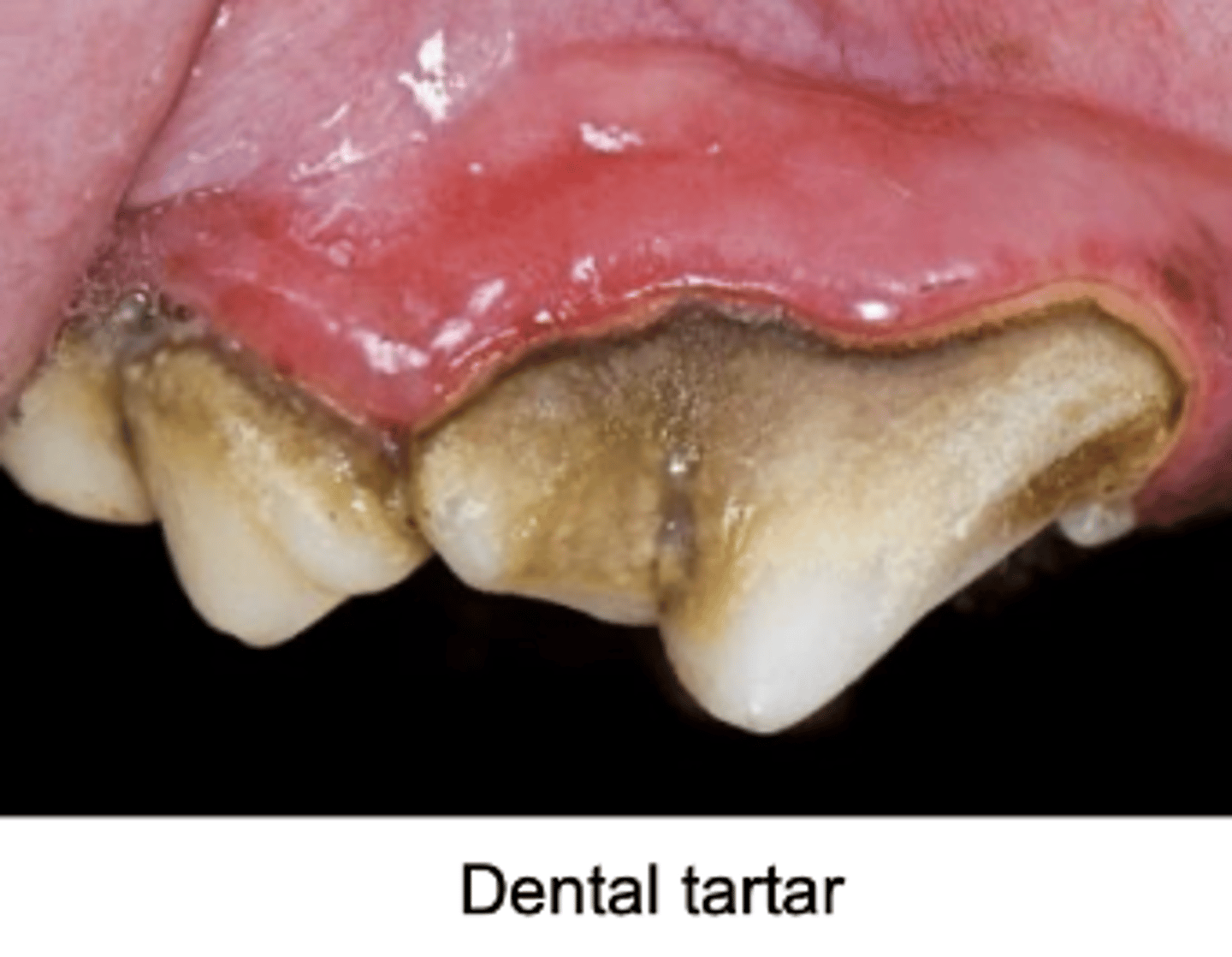
What lesions/changes are associated with gingivitis/stomatitis?
- Reddened, proliferative gingiva
- Vesicles, papules, erosions and ulceration
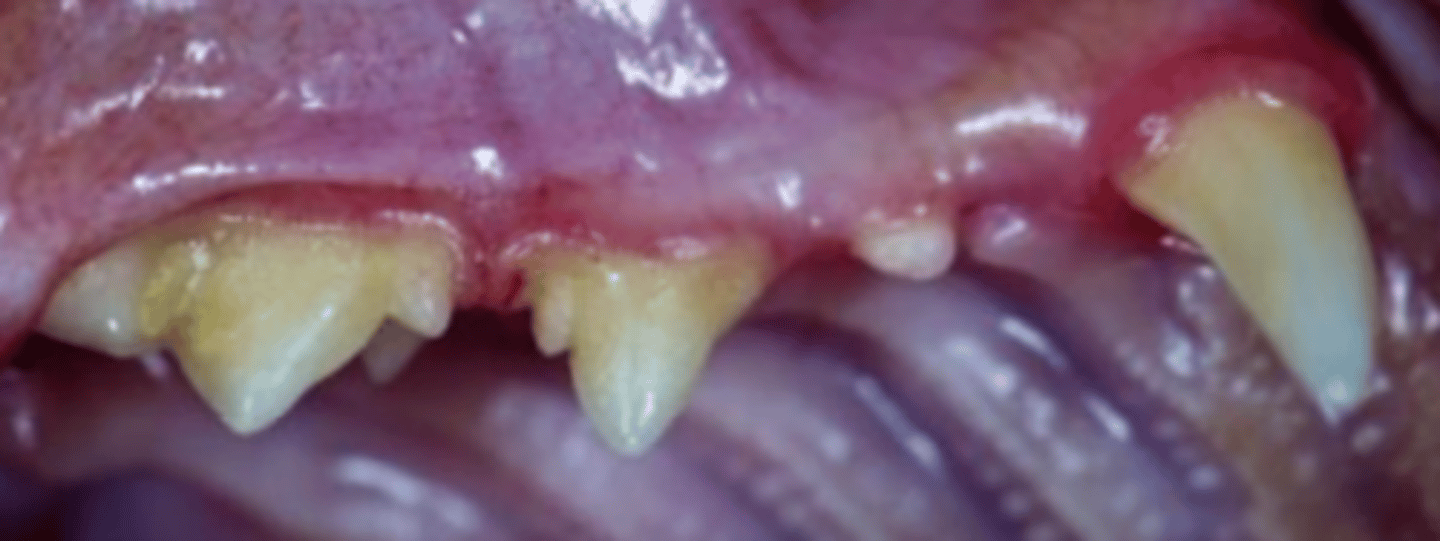
What is the etiology of gingivitis and stomatitis?
- Multifactorial: poor dental hygiene, infection, chemical injury, trauma, immunologic diseases, systemic diseases, FIV/FeLV infection in cats
What type of gingivitis generally occurs in cats?
- Plasmacytic
While large animals are not commonly affected by periodontal disease, they are commonly affected by what?
- Wave mouth and step mouth

In what species does wave mouth/step mouth (abnormal wearing of teeth) commonly occur? What might be observed on necropsy?
- Aged ruminants and camelids
- They may be ill thrift and have unchewed grain in the stomach
What is infundibular impaction? What species are affected?
- Food impaction: Impaction of food within the infundibulum of the tooth.
- Cattle, camelids, sometimes horses
What are some possible sequelae to infundibular impaction?
- Leads to bacterial colonization, (tetanus or botulism in horses) acid production, demineralization
- Osteomyelitis of the jaw in severe cases
- Illthrift/off-feed
- Sepsis
- Painful mouth
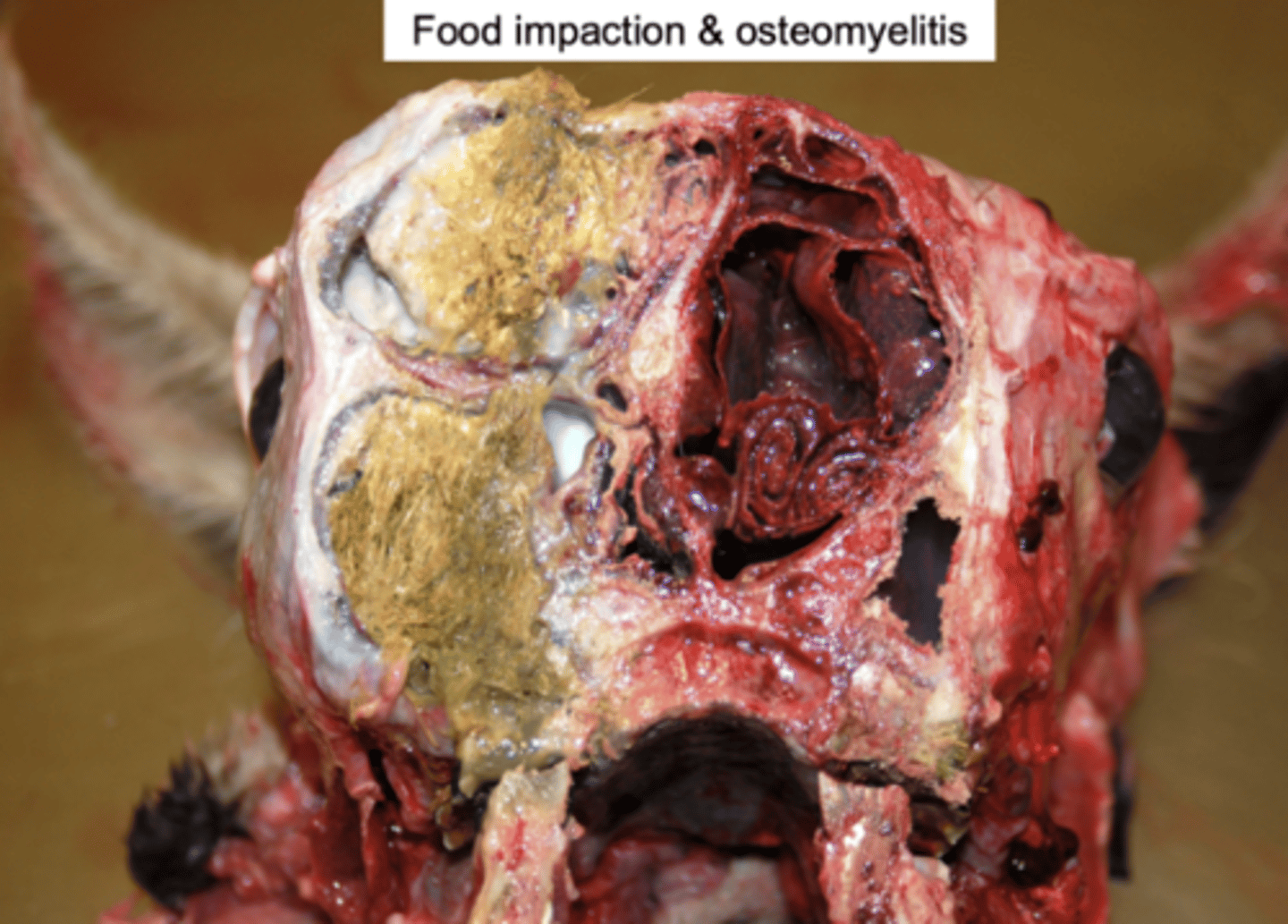
Food impaction is more or less of a problem in carnivores?
- Less of a problem
Feline eosinophilic granuloma complex occurs in which species?
- Most common in cats, but also in dogs (especially Siberian Huskies)
What are the effects of Feline Eosinophilic Granuloma Complex?
- "Indolent/Rodent ulcers" mainly on the lips, but also on the tongue, palate, gingiva, and pharynx
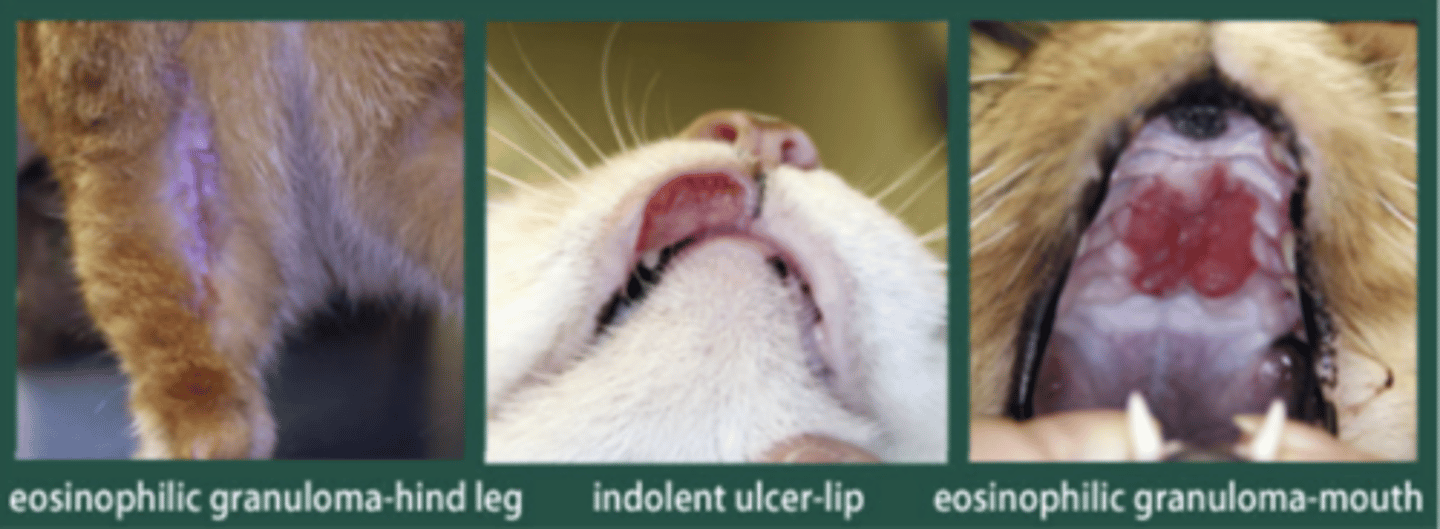
What is the etiology behind the Feline Eosinophilic Granuloma Complex?
- Thought to be hypersensitivity, but pathogenesis is still unclear
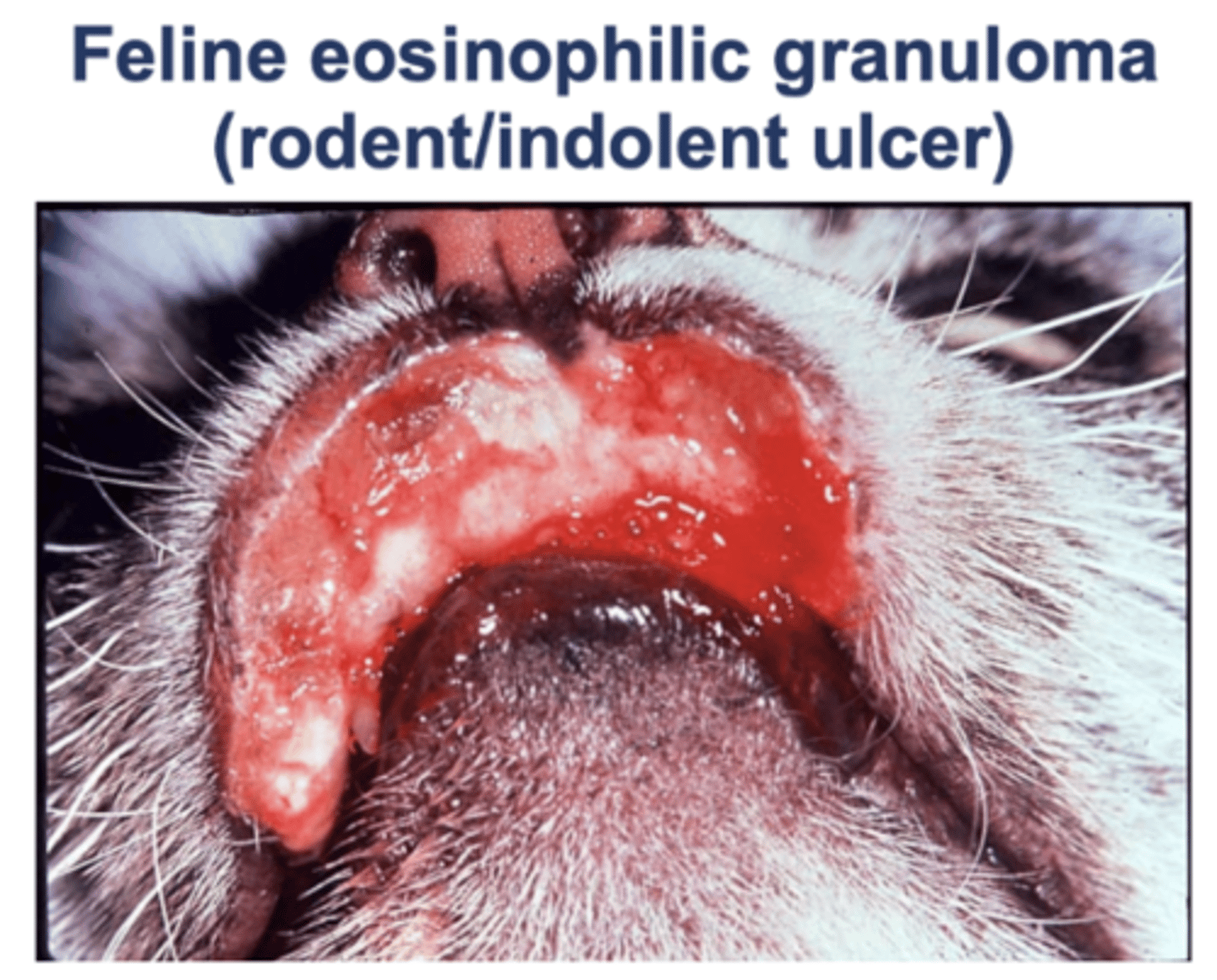
What will be observed on histopathology of a tissue with an indolent ulcer due to Feline EosinophiliC Granuloma Complex?
- Infiltrates of eosinophils & macrophages, possibly giant cells
Uremic stomatits/glossitis commonly occurs in cats secondary to what?
- Chronic renal disease resulting in chronic uremia
Describe the pathogenesis of uremic stomatitis/glossitis.
- High urea concentration in the blood -> Transformation of urea into ammonia by the bacteria in the oral cavity -> Irritation of the oral/lingual epithelium -> Ulceration of the mucosa
Describe the typical lesions/signs in a patient with uremic stomatitis/glossitis.
- Uremic stomatitis/glossitis typically have foul breath and bilaterally symmetrical ulceration on the ventral aspect of the tongue
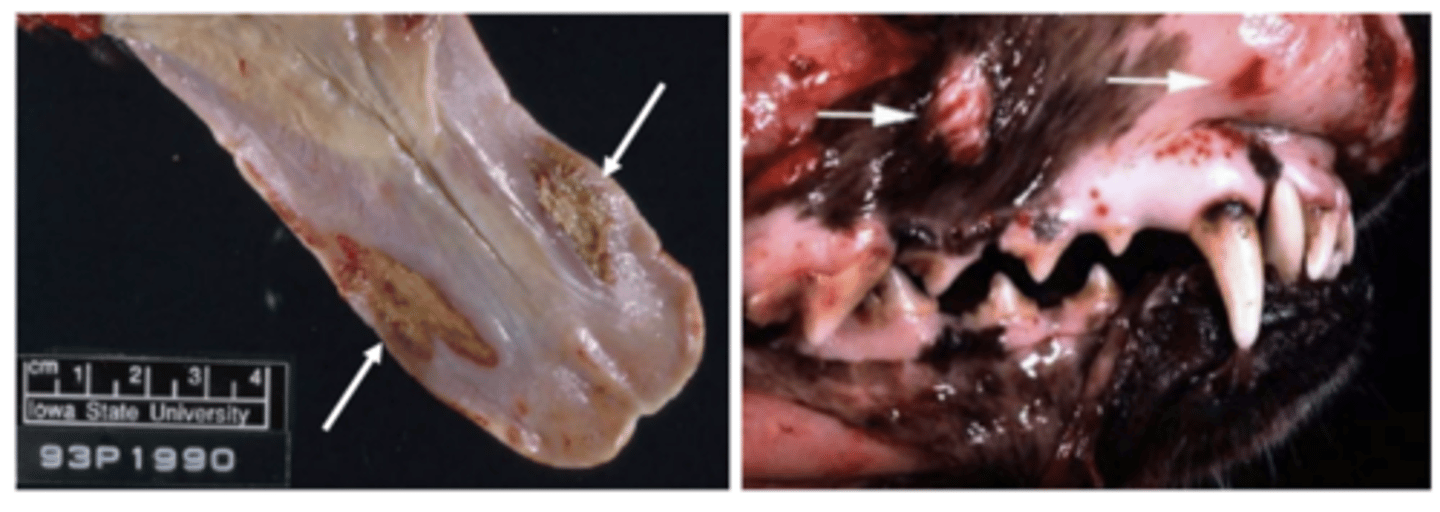
Describe the presentation of viral vesicular stomatides.
- All look pretty much the same between species... Vesicles and ulcerations throughout the mouth
Why are viral vesicular stomatides concerning?
- Non-fatal but debilitating due to economic losses
What are differentials for vesicles/ulcerations in the mouth of a pig?
- FMD
- Swine vesicular disease
- Vesicular stomatitis
- Vesicular exanthema of swine
- Seneca virus disease
What viral vesicular stomatide affects horses, ruminants and swine?
- Vesicular stomatitis
What is aphthae?
- Ulcers in the mouth
How are various viral vesicular stomatides differentiated?
- PCR or ELISA
San Miguel Sea Lion virus is a form of which viral vesicular stomatide?
- Vesicular exanthema
What is the only viral vesicular disease in horses?
- Vesicular Stomatitis virus
Which vesicular stomatides are exotic to the U.S.?
- FMD
- Vesicular stomatitis
- Vesicular exanthema of swine
- Swine vesicular disease
What are the classic lesions seen in swine affected by FMD?
- Coronary bands are affected and sloughing of hoof is severe and painful
- Piglets can also get myocarditis from this virus as well
How are erosive/ulcerative stomatitis and vesicular stomatides differentiated grossly?
- With ulcerative/erosive stomatitis, there should be no actual vesicles. However, older vesicles found with vesicular stomatides can appear as ulcers and erosions
What is erosive/ulcerative stomatitis usually associated with in ruminants?
How do these animals present?
- Highly pathogenic system disease (i.e. BVDV, Rinderprest, MCF, Bluetongue Virus)
- Normally they won't present with vesicles but rather extensive ulceration and hemorrhage/hyperemia
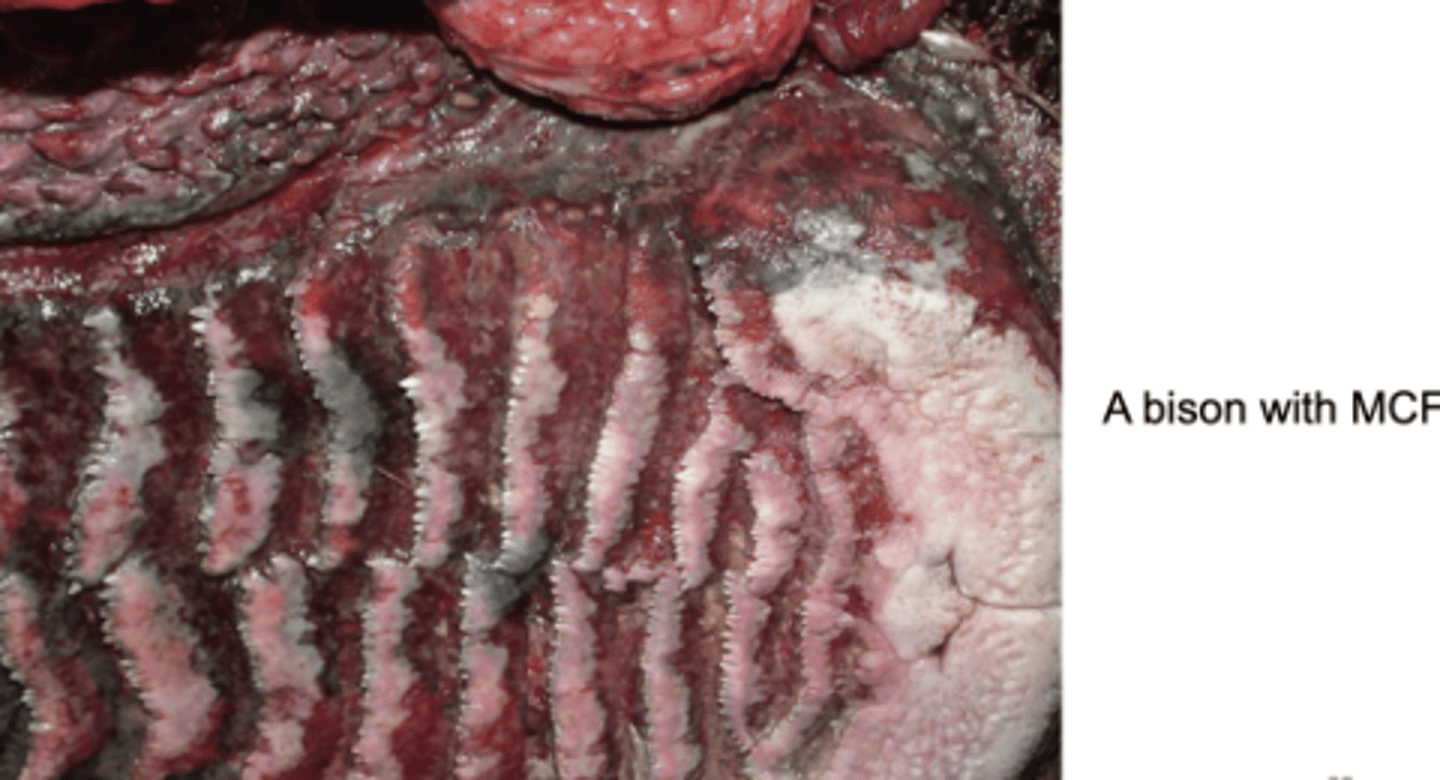
What is erosive/ulcerative stomatitis associated with in cats?
- Feline calicivirus and Feline herpesvirus-1
How can one differentiate between Feline calicivirus and FHV-1 in a cat presenting with erosive/ulcerative stomatitis?
- Need histopathology and ancillary testing (both present with oral and lingual ulceration)
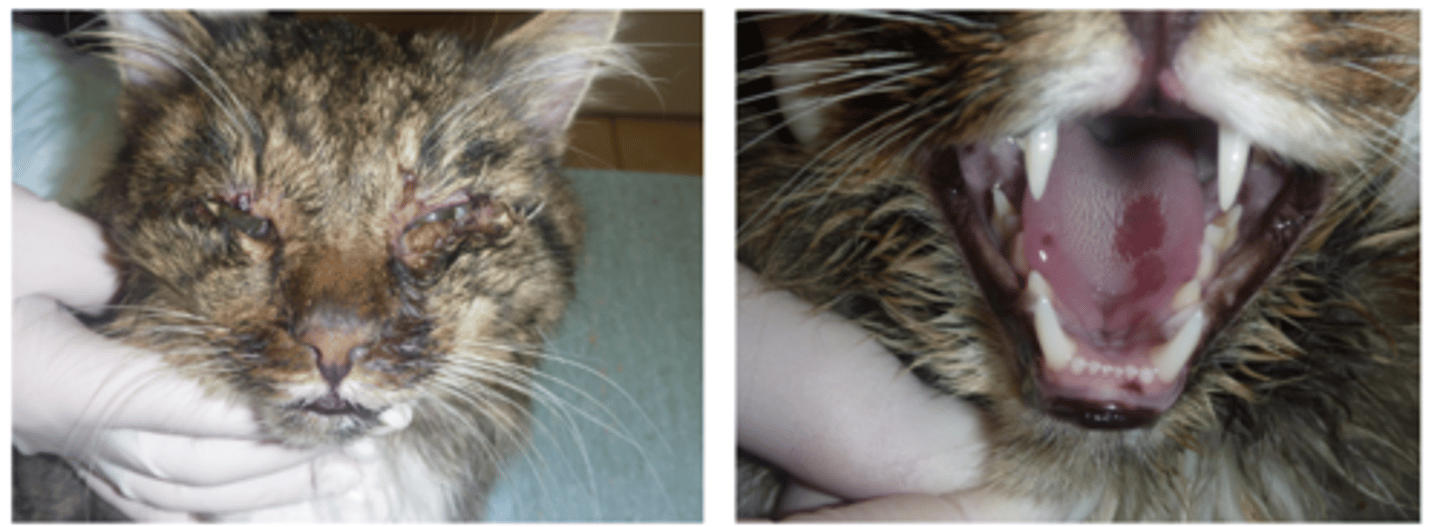
Describe the mortality and morbidity of Parapox virus.
- Low and low
What are two examples of diseases results form Parapox virus infections?
1) Bovine popular stomatitis
2) Contagious ecthyma (ORF)
Describe the lesions associated with Bovine papular stomatitis caused by Parapox virus infections.
- Papules on the nares, muzzle, gingiva, tongue, buccal cavity, palate and esophagus
What species are affected by contagious ecthyma (ORF)? What lesions do they present with?
- Sheep and goats
- Present with papules, vesicles, pustules, scars, nodules in areas of skin abrasion (faces, udder, teats, coronary bands, anus; occasionally esophagus and rumen).
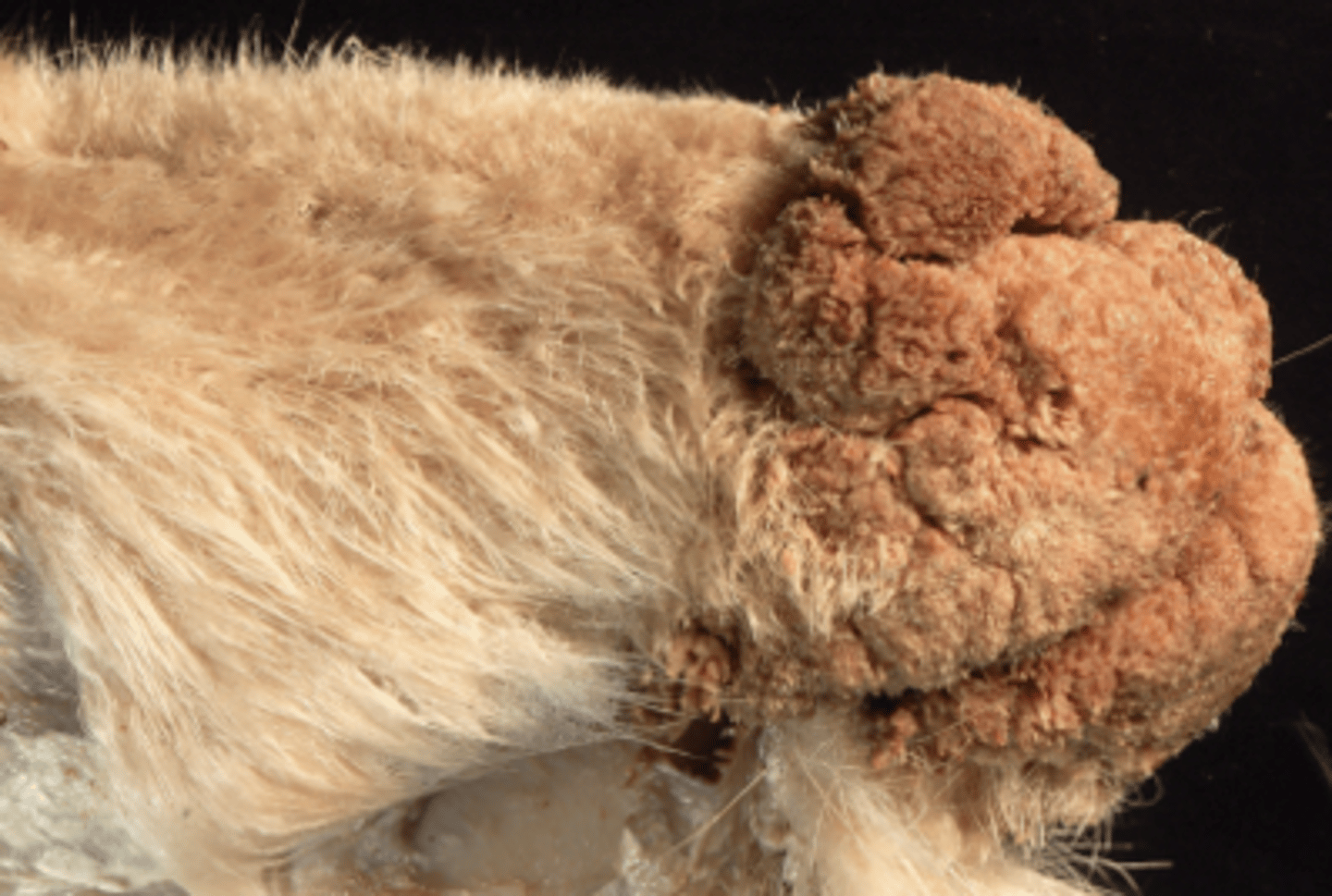
What should one be conscientious of when handling a patient suspected of having contagious ecthyma (ORF)?
- It is zoonotic
What is the classic lesion of puppies (alimentary related) which is associated with in utero Canine Distemper Virus infections?
- Enamel hypoplasia (oral cavity)
Describe the pathogenesis of enamel hypoplasia resulting from Canine Distemper Virus infections.
- In utero infection with Canine Distemper Virus during odontogenesis results in necrosis of the enamel organ (odontoblasts), leading to enamel hypoplasia.
What is the causative agent of wooden tongue?
- Actinobacillus lignieresii, a gram negative bacteria
What lesions are associated with wooden tongue?
- Multifocal chronic pyogranulomatous glossitis

What is the causative agent of lumpy jaw?
- Actinomyces bovis, a gram positive bacteria
What are the lesions associated with lumpy jaw?
- Chronic pyogranulomatous osteomyelitis with concurrent osteolysis and new bone formation

What is the typical pathogenesis of lumpy jaw?
- A trauma usually acts as the portal of entry
Describe the pathogenesis of Calf Diphtheria, including the causative agent.
- Typically occurs secondary to abrasion and/or trauma to the mucosal epithelium of the oral cavity or larynx (classic location is larynx). The causative agent, Fusobacterium necrophorum, is common in the URT of cattle when the mucosa is compromised. This leads to bilateral necrotizing laryngitis.
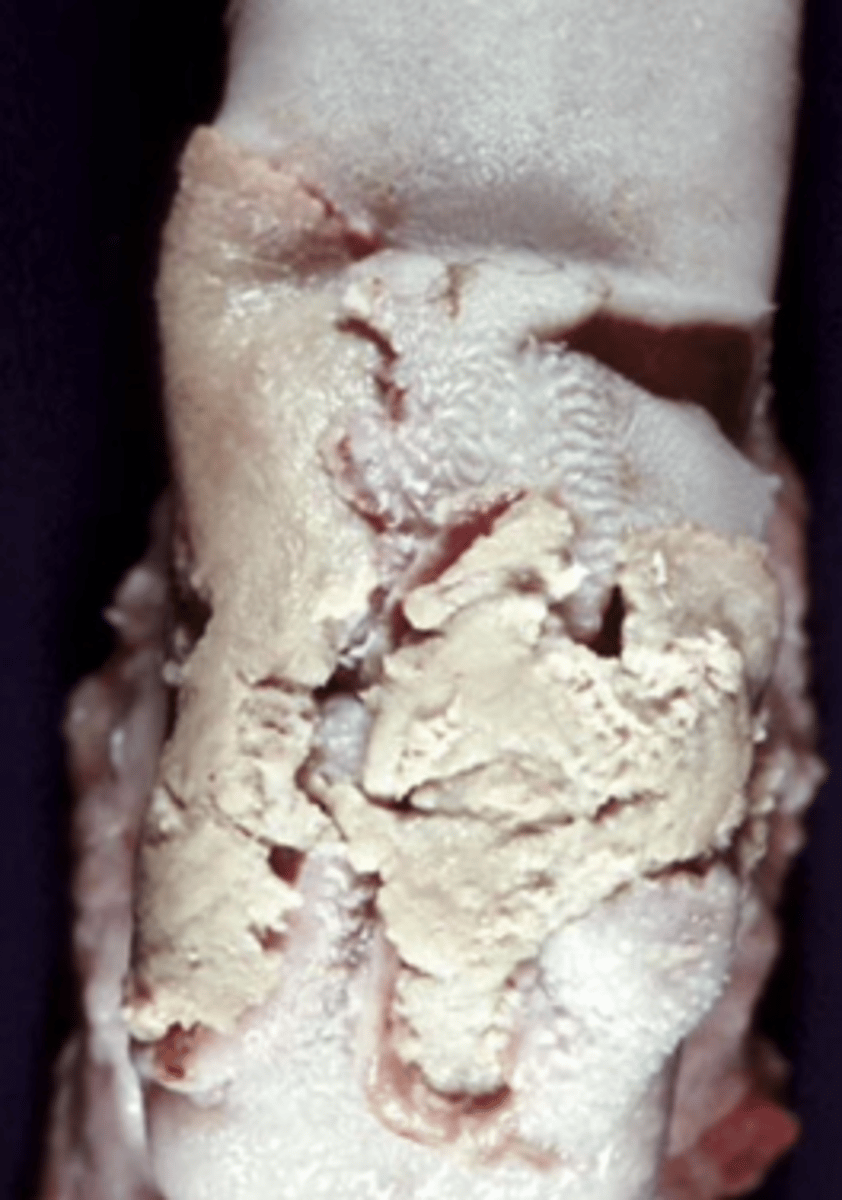
What does Calf Diphtheria result in?
- Bilateral necrotizing laryngitis
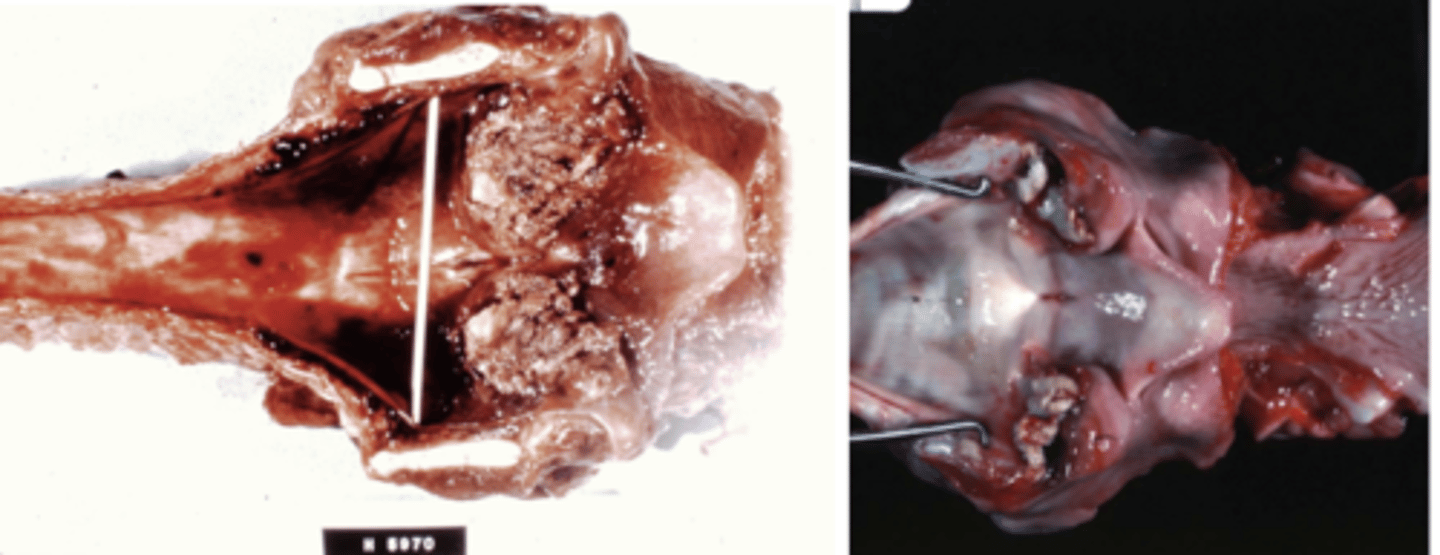
What is thrush?
- A superficial Candida albicans infection
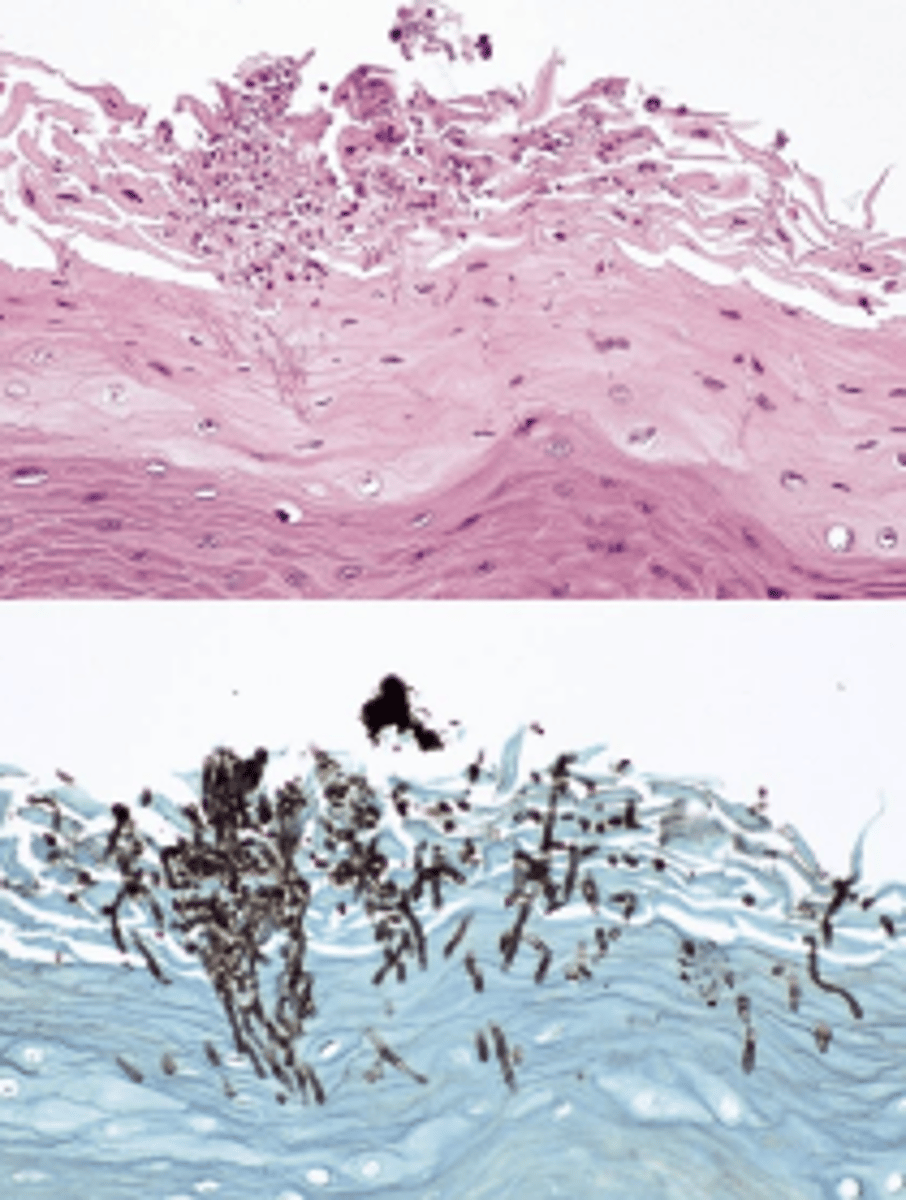
What are some causes/predispositions to thrush?
- Prolonged use of antibiotics
- High glucose (feeds the yeast)
- Immunodeficiencies
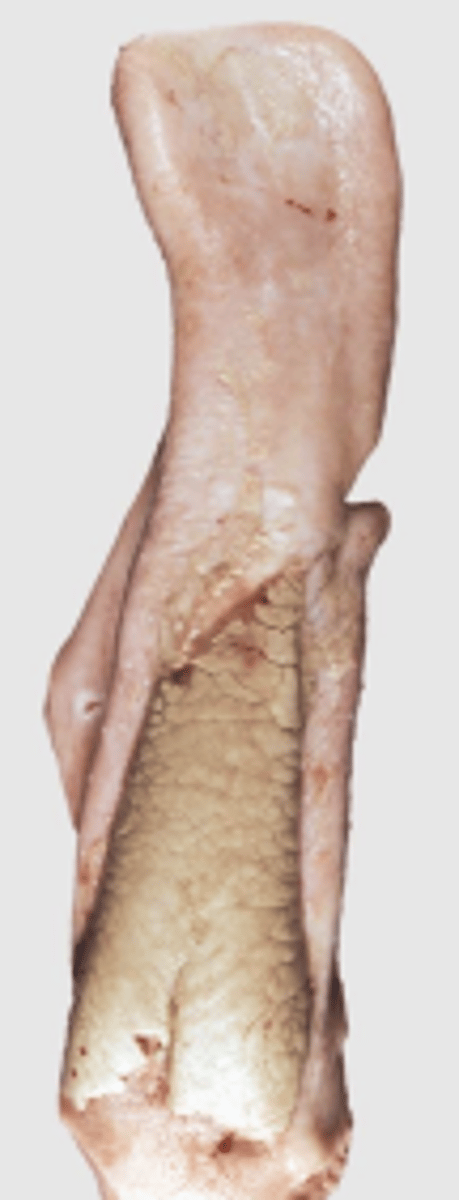
Where does thrush usually occur in birds?
- Crop
What is inflammation of the crop known as?
- Ingluvitis
Due to the high cell turnover rate of a lot of the tissues in the alimentary canal and the activities of mucosal immunity, describe the inflammation and lesions which typically occur.
- Chronic inflammation typically produces proliferative lesions
What is the cause of a ranula/salivary mucocoele?
- Rupture of a salivary duct due to trauma (usually)
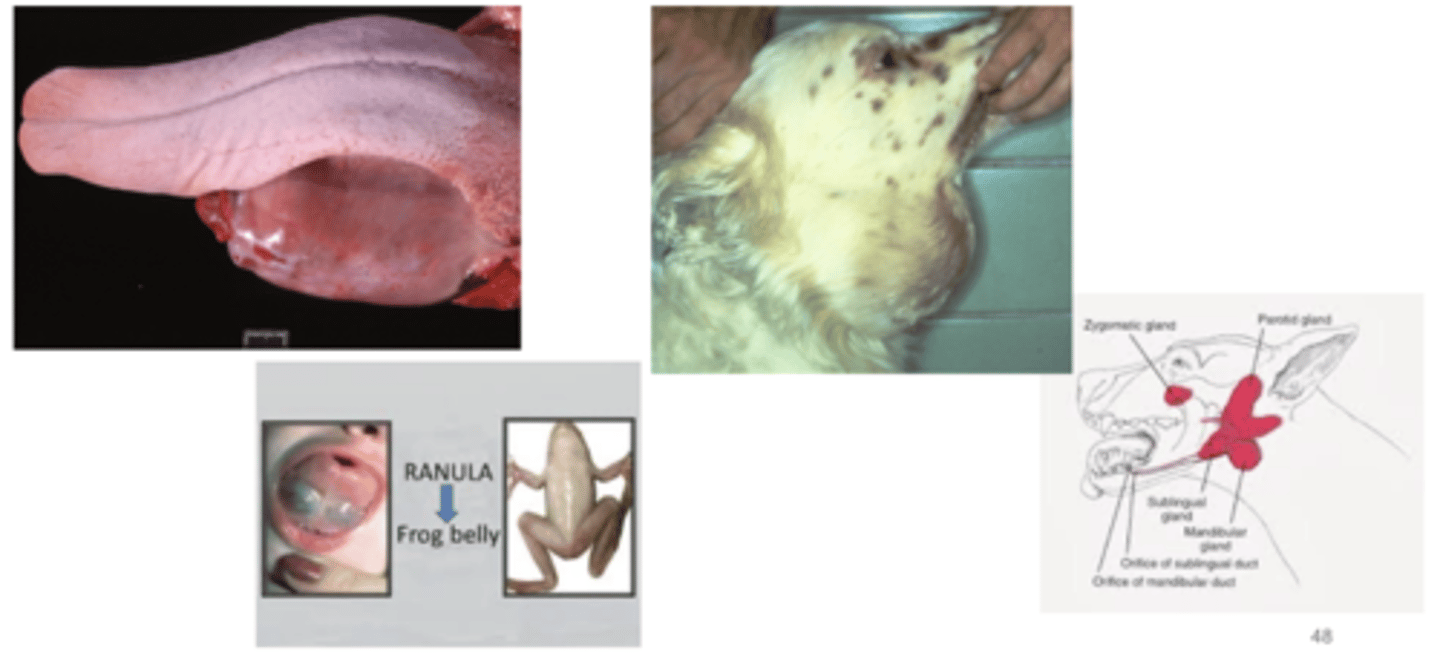
What is the word for inflammation of salivary glands?
- Sialodenitis
What is a known cause of sialodenitis?
- Rabies; Not many infectious or non-infectious entities cause salivary gland inflammation
What is a ranula?
- Cyst of sublingual or submaxillary salivary gland, in the floor of the mouth
What is a salivary mucocoele?
- Non-epithelial lined pseudocyst containing saliva (trauma to ducts)
What is calcinosis cricumscripta? Describe its pathogenesis.
- Recall from the skin unit, it is an accumulation of calcified material over pressure points such as the elbow and sternum (dystrophic mineralization), which can also present as multifocal to coalescing areas of mineralization in the alimentary canal.
- The pathogenesis is unclear (calcium deficits? Ischemia? On the tongue could be secondary to trauma?)
Is a nasopharyngeal polyp neoplastic?
- No
What are nasopharyngeal polyps?
- Pedunculated growths arising from the mucosal surface of the nasal cavity or nasopharynx which can also arise from the lining of the auditory canal or middle ear and obstruct the canal.
Describe the pathogenesis of nasopharyngeal polyps.
- Cause/pathogenesis is unknown but it is usually associated with hyperplasia of mucous membranes and chronic inflammation of underlying tissues.
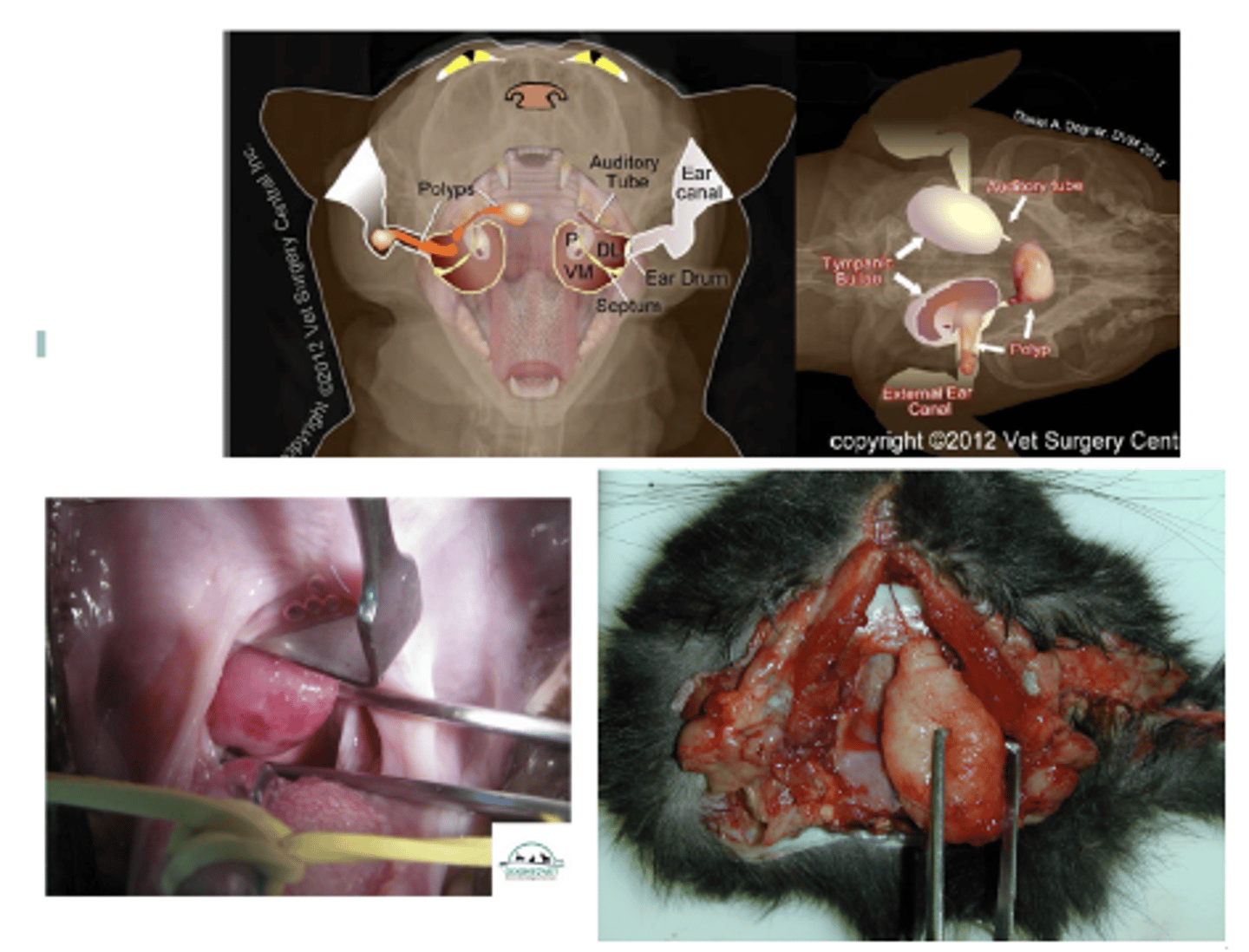
Gingival hyperplasia occurs in response to what? What animals is it common in?
- Response to chronic inflammation
- Common in brachycephalic dogs
What is gingival hyperplasia?
- A localized lesion of overgrown gingival tissue which can obscure teeth

What drug is gingival hyperplasia associated with in dogs? What is it difficult to distinguish from?
- Cyclosporine A (immunosuppressive drug); Up to 90% of patients
- Difficult to distinguish from epulis
What is an oral papilloma?
- A benign proliferation (histological fronds of stratified squamous epithelium) caused by papillomaviruses (dsDNA viruses) which occur in various regions in the oral cavity and throughout the GI tract.
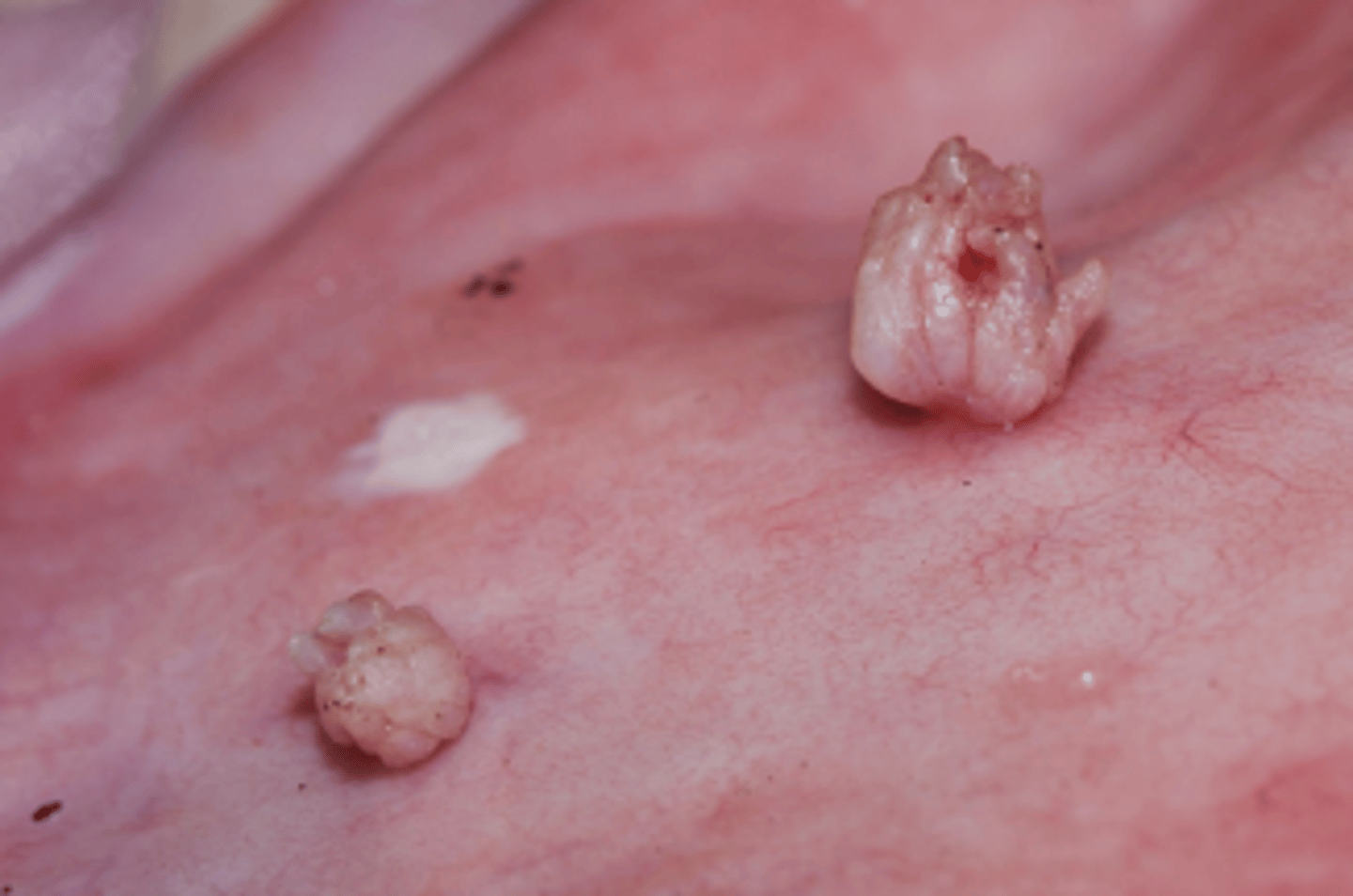
Describe the progression of oral papillomas.
- Typically regress spontaneously (associated with immunity)
- Can undergo focal transformation to invasive squamous cell carcinoma
- Note the intranuclear inclusion bodies in the image
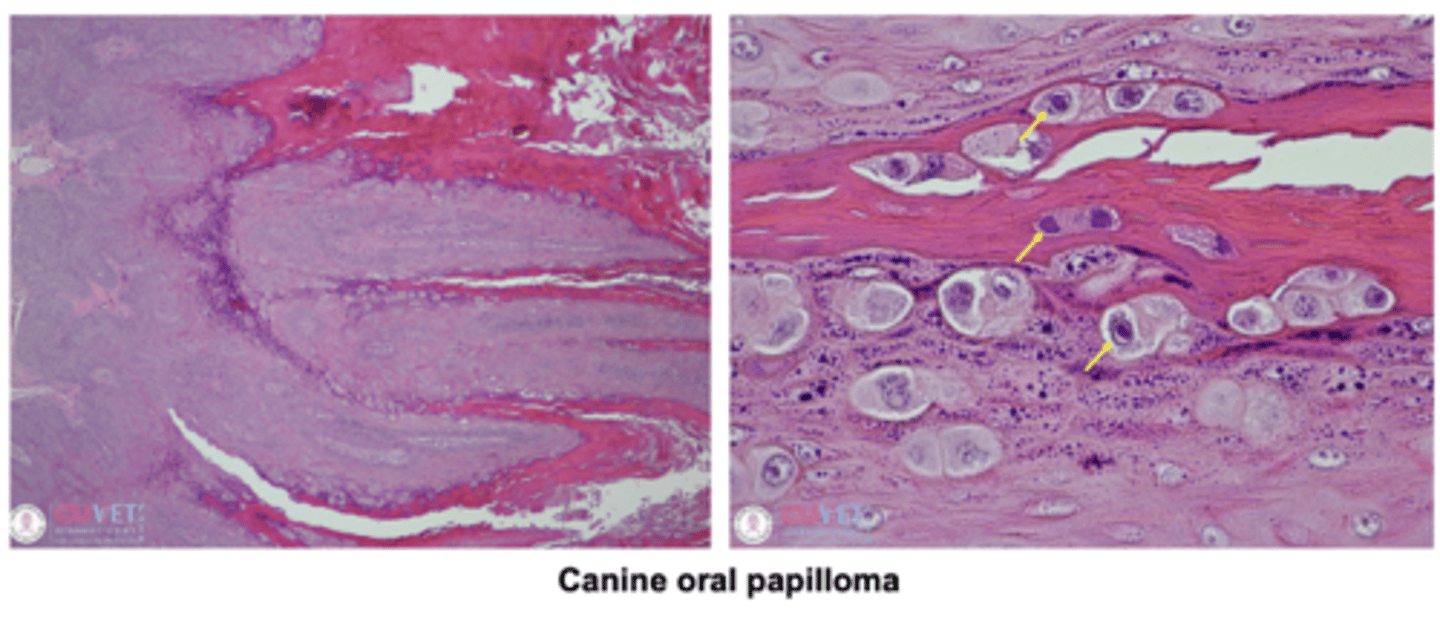
What is a peripheral odontogenic fibroma?
- Benign fibrotic neoplasm (?) of the periodontal ligament that may include entrapped cords of odontogenic epithelium, typically forming one or more nodular lesions
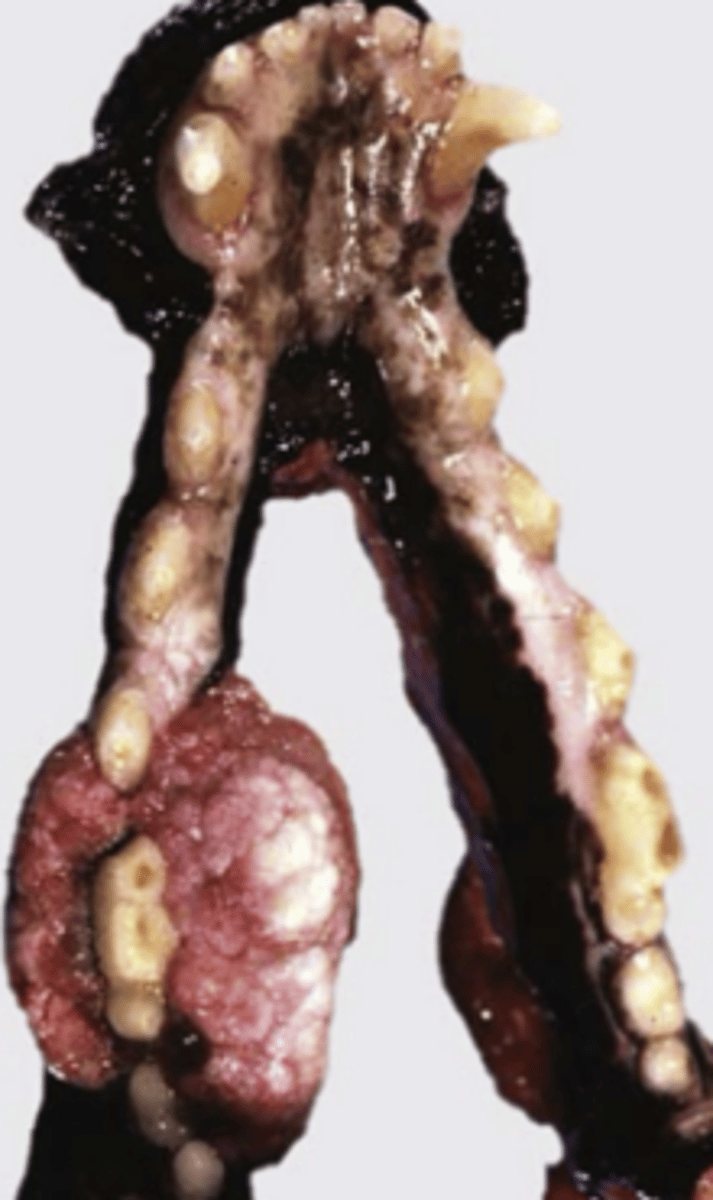
What is another name for peripheral odontogenic fibromas? What are they difficult to distinguish from?
- Fibromatous epulis
- Can be difficult to distinguish from gingival hyperplasia grossly
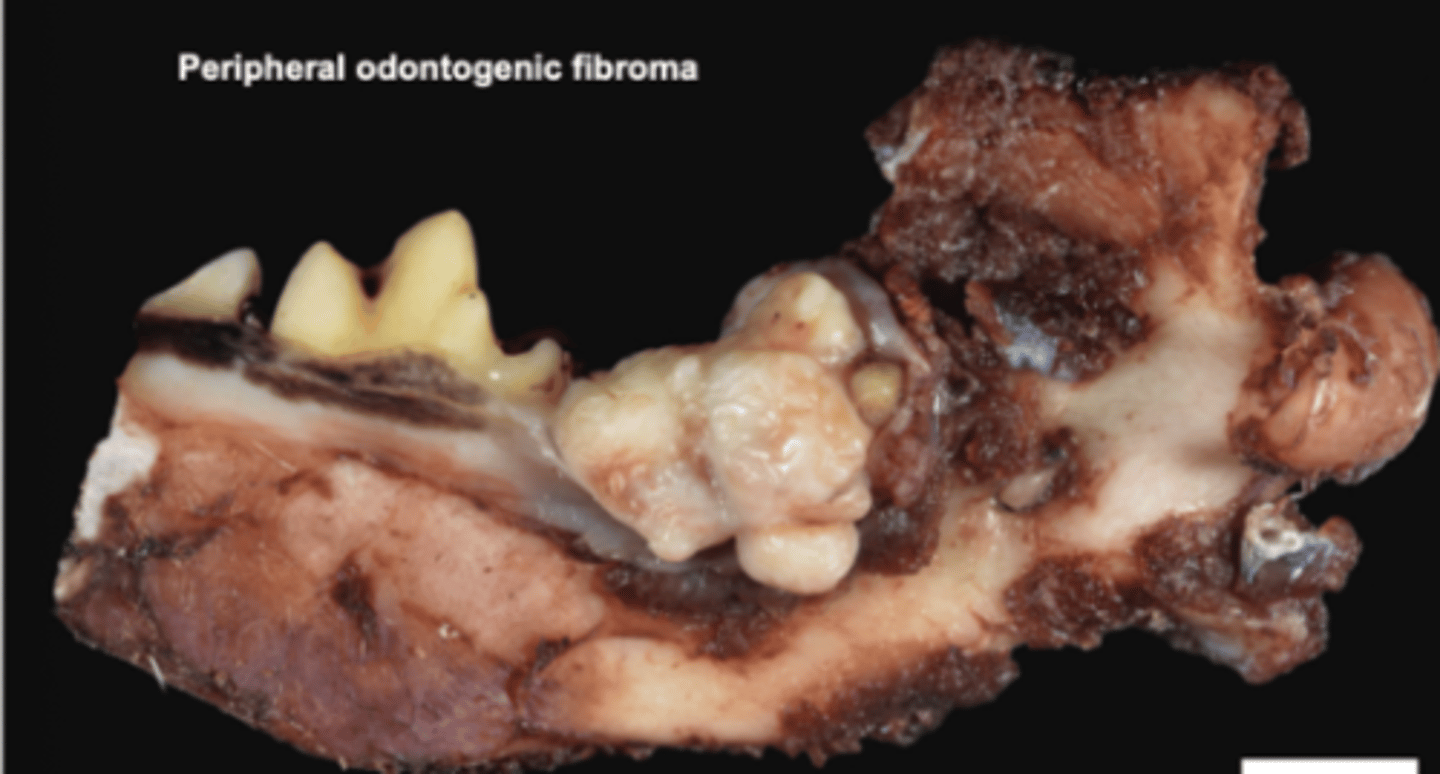
Describe the progression/behavior of peripheral odontogenic fibromas.
- Not invasive, quite well behaved, surgery is usually curative
- Can form bone (ossifying epulis)
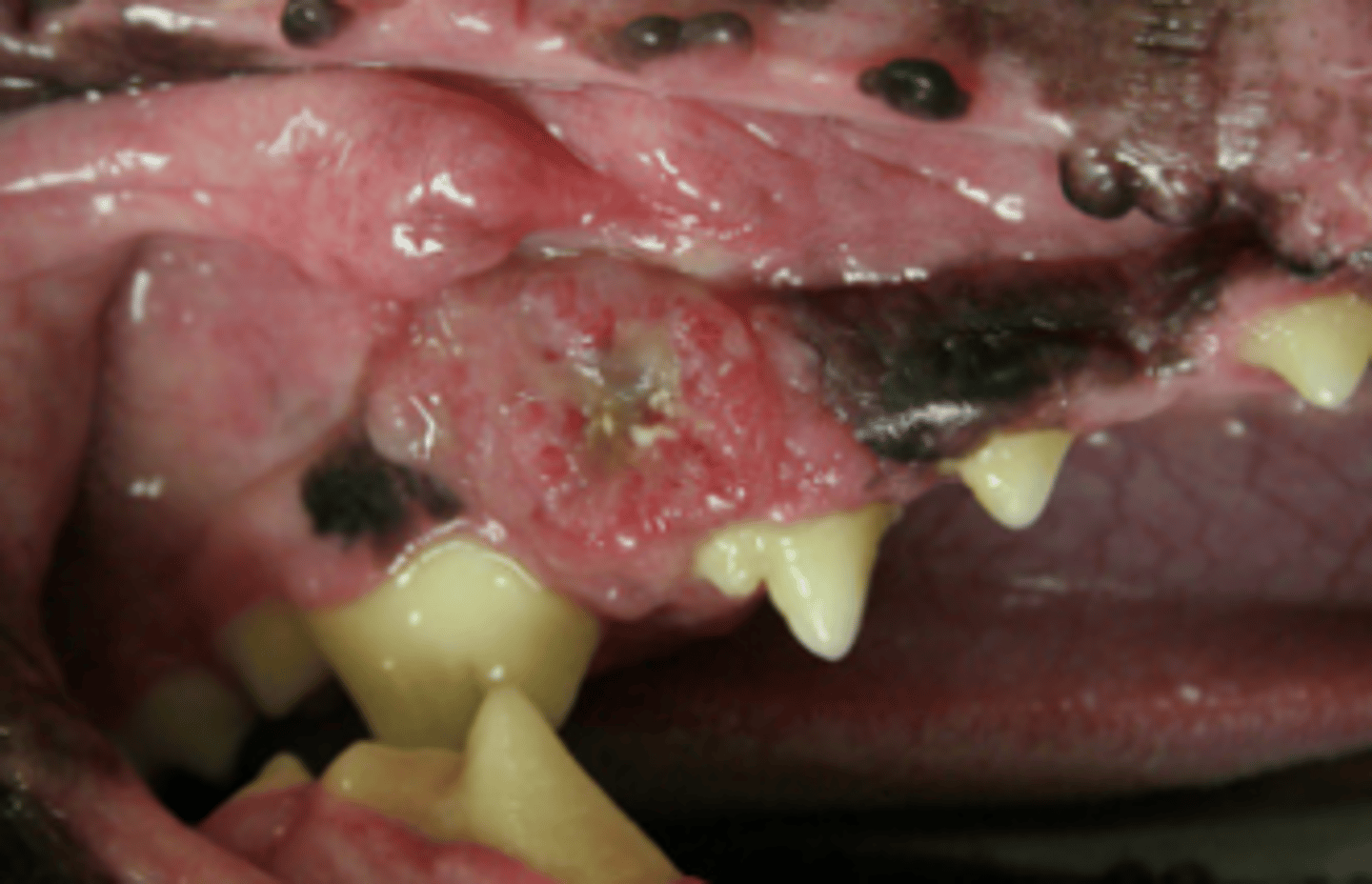
What is a canine acanthomatous ameloblastoma? Describe its biological behavior
- Locally aggressive neoplasm of odontogenic epithelium which can be highly locally aggressive and invasive resulting in osteolysis of the jaw (invades alveolar bone); Metastasis is not reported in dogs
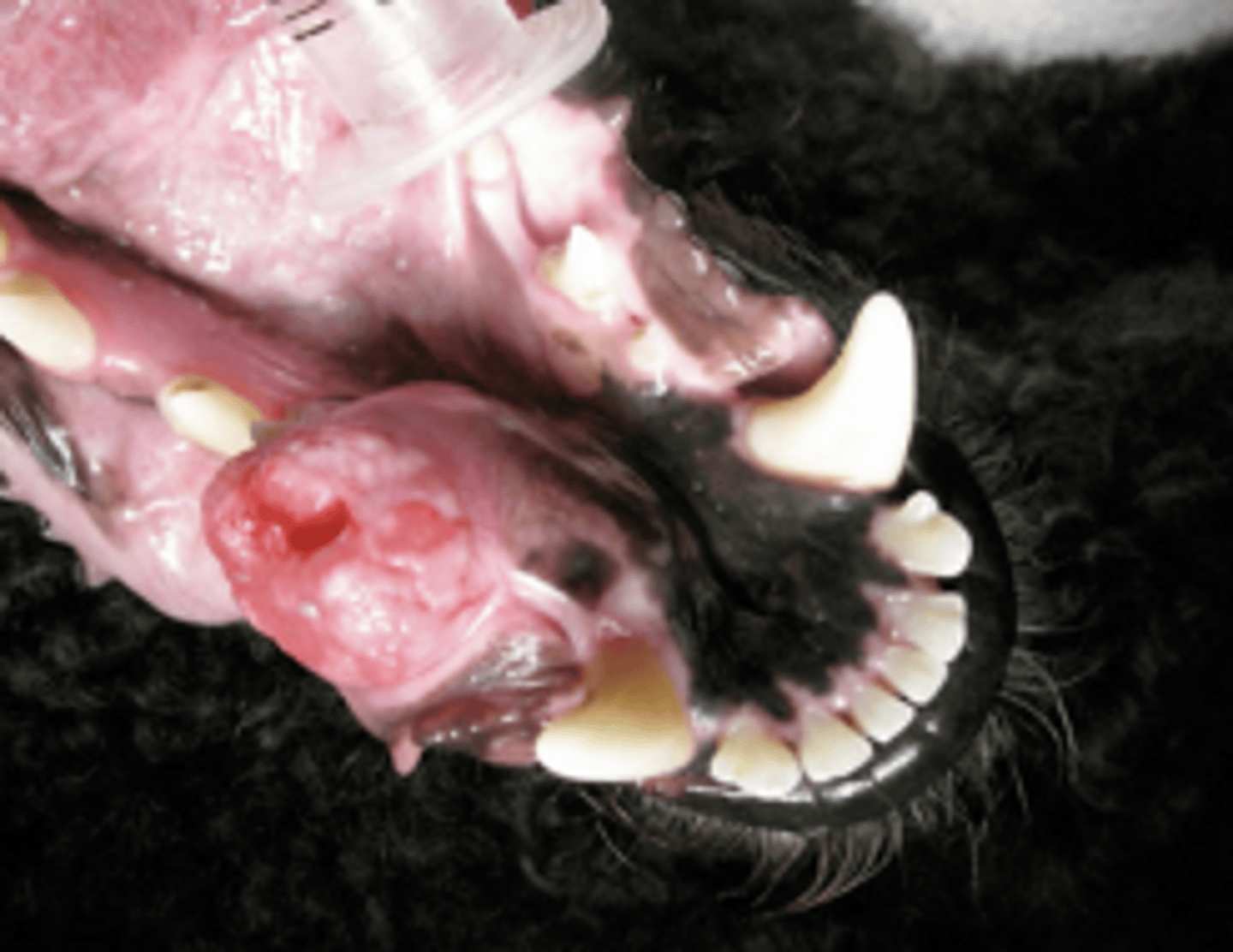
Describe the treatment for canine acanthomatous ameloblastoma.
- Radical surgery is sometimes necessary (hemimandibulectomy)
Where does squamous cell carcinoma commonly occur in cats and dogs? In what other species is SCC common?
- Cats: ventral surface of the tongue
- Dogs: Tonsils
- Also common in hedgehogs
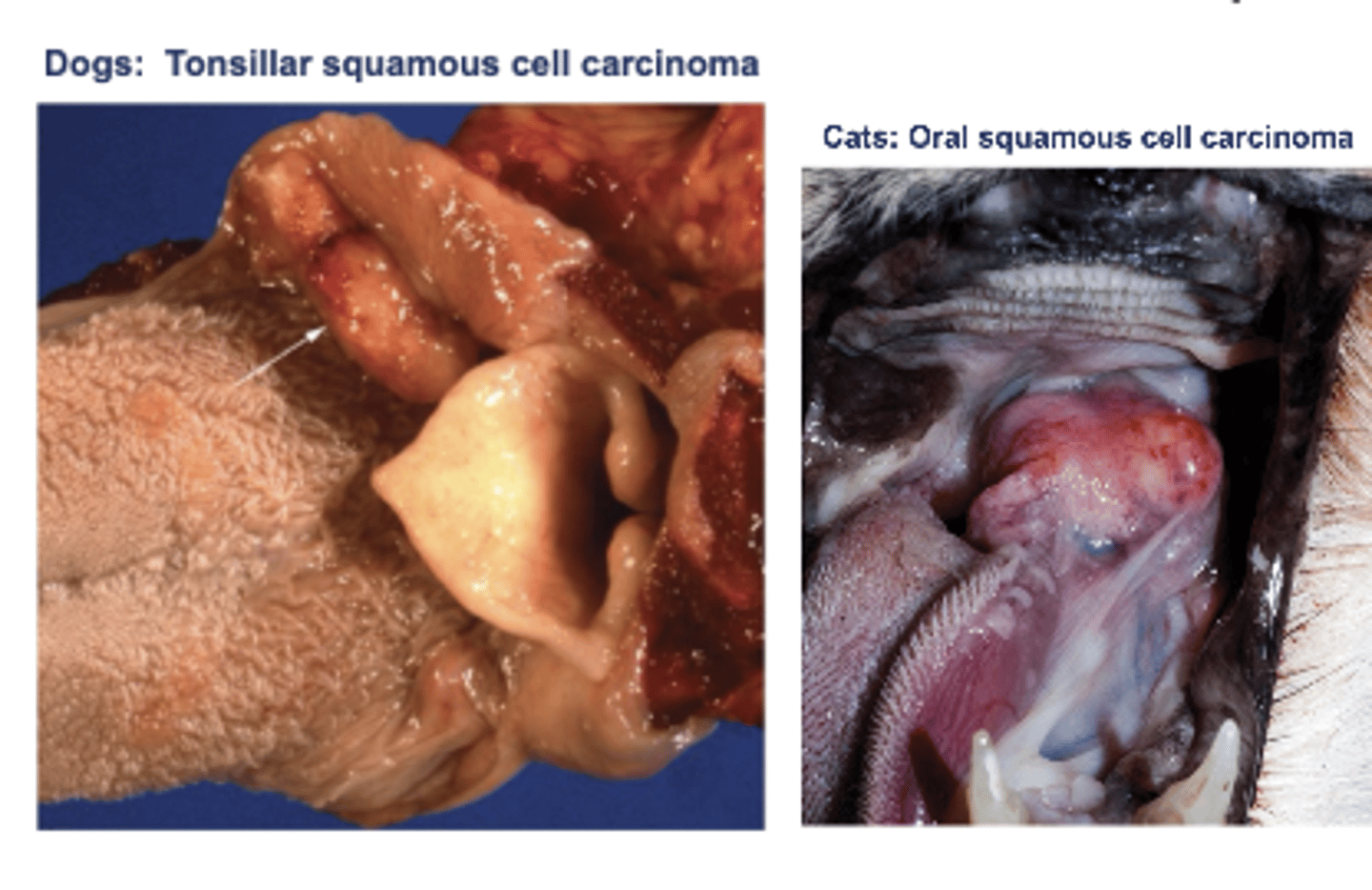
What lesions result from oral SCC?
- Erosive lesions leading to loosening of teeth, infiltration of bone, osteolysis
Describe the metastatic behavior of oral SCC.
- 5-10% will metastasize - Often in late stage tonsilar SCC metastasize more frequently
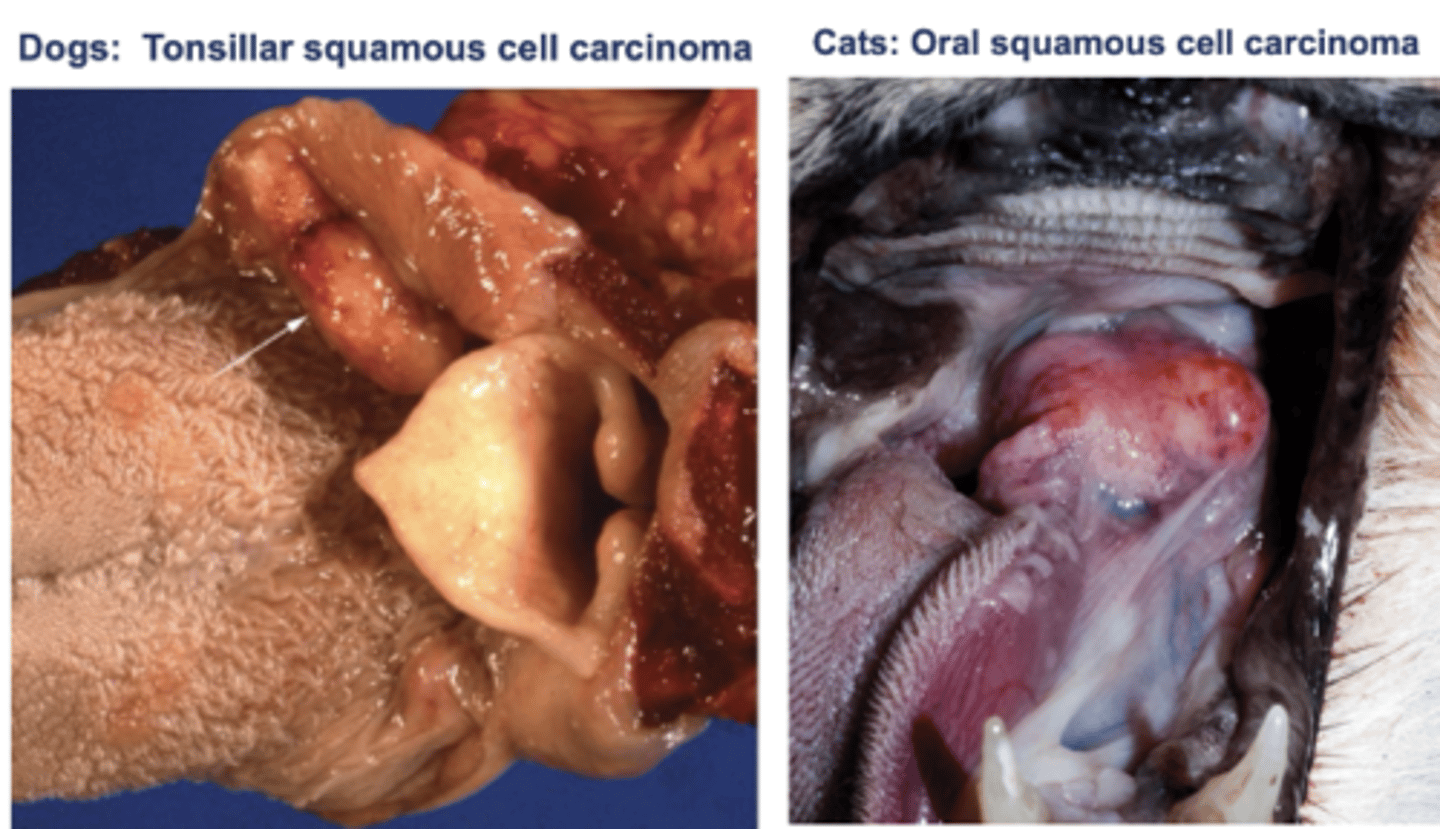
Describe the histological appearance of SCC.
- Invasive cords of squamous epithelium, often with scirrhous/desmoplastic response - May form keratinized "pearls"
Describe the typical biological behavior of oral melanocytic tumors.
- Usually malignant with frequent metastasis (to brain and lung)
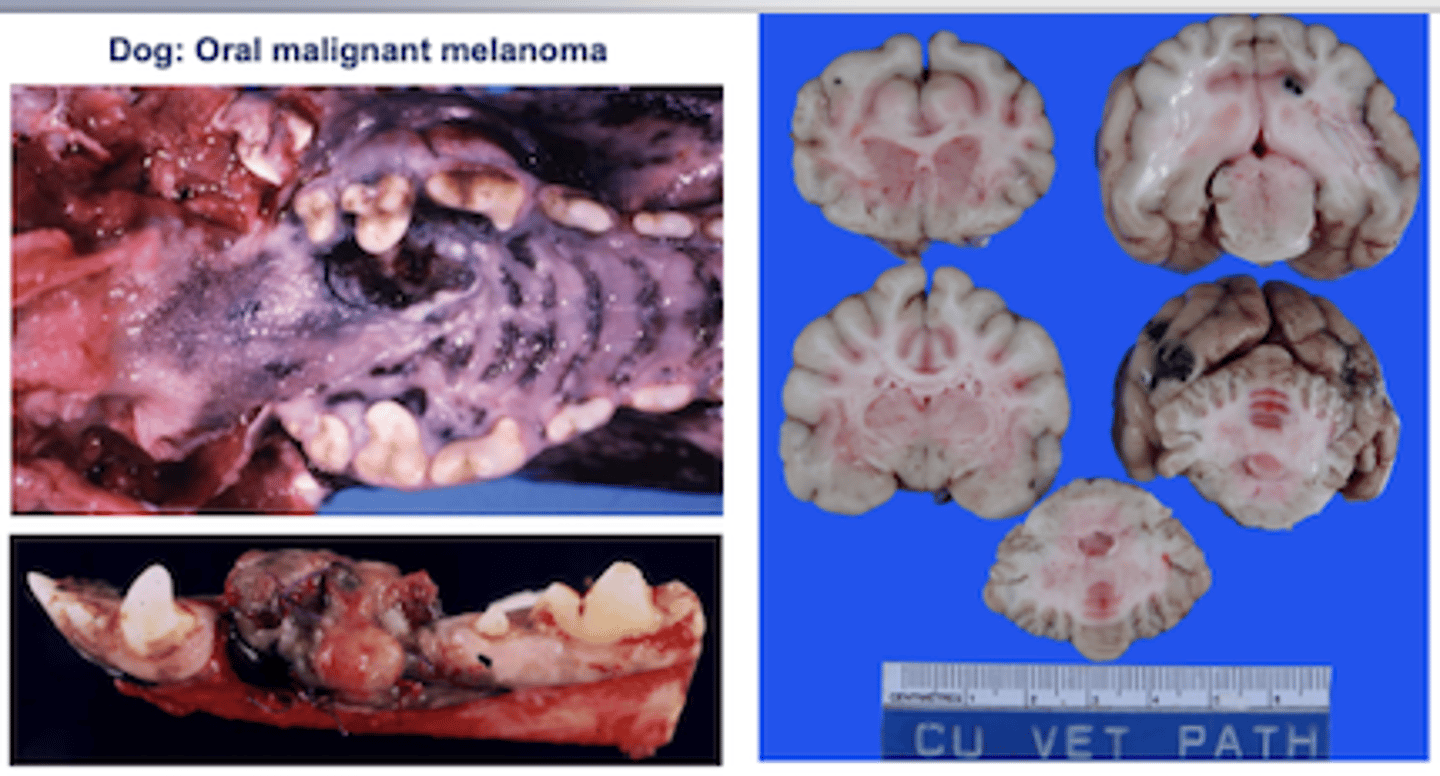
Describe the histologic and gross appearance of oral melanocytic tumors.
- Histo: Can vary from spindle to epithelial-like morphology
- Gross: May contain melanin (grossly appear black) but may be amelanocytic (without obvious coloration)
Oral melanocytic tumors must be contrasted/differentiated from what?
- Contrast with benign melanocytomas occurring in skin around mouth (mostly lack cellular atypia, low mitotic figures, well demarcated)
Describe the normal composition of the esophageal mucosa.
- Lined by stratified squamous epithelium, keratinized in cattle, horses, and pigs

Describe how the muscular tunic of the esophagus varies between each of the following species:
A. Dogs and ruminants
B. Horses
C. Pigs
D. Cats and primates
A. Fully striated muscle
B. Distal 1/3 smooth muscle
C. Middle 1/3 mixture of smooth and skeletal muscle
D. Distal 2/3 is smooth muscle
What is megaesophagus?
- Not a single disease; a combination of disorders in which the esophagus dilates and motility is lost

What are causes of megaesophagus?
- Congenital
- Chronic obstruction (FB, tumors, vascular ring anomaly)
- Toxins (lead, thalium)
- Endocrinopathy (hypoadrenocorticisim, hypothyroidism)
- Autoimmune disease (myasthenia gravis)
- Idiopathic (adult-onset)
Are most cases of megaespphagus transient or permanent?
- Most cases are permanent and require lifelong care
What are the effects/sequelae of megaesophagus?
- Lack of tone -> Dysautonomia
(Either way things don't move)
- Regurgitation after eating
- Aspiration pneumonia
What can be done to help prevent aspiration pneumonia in animals with megaesophagus?
- Lifted bowls
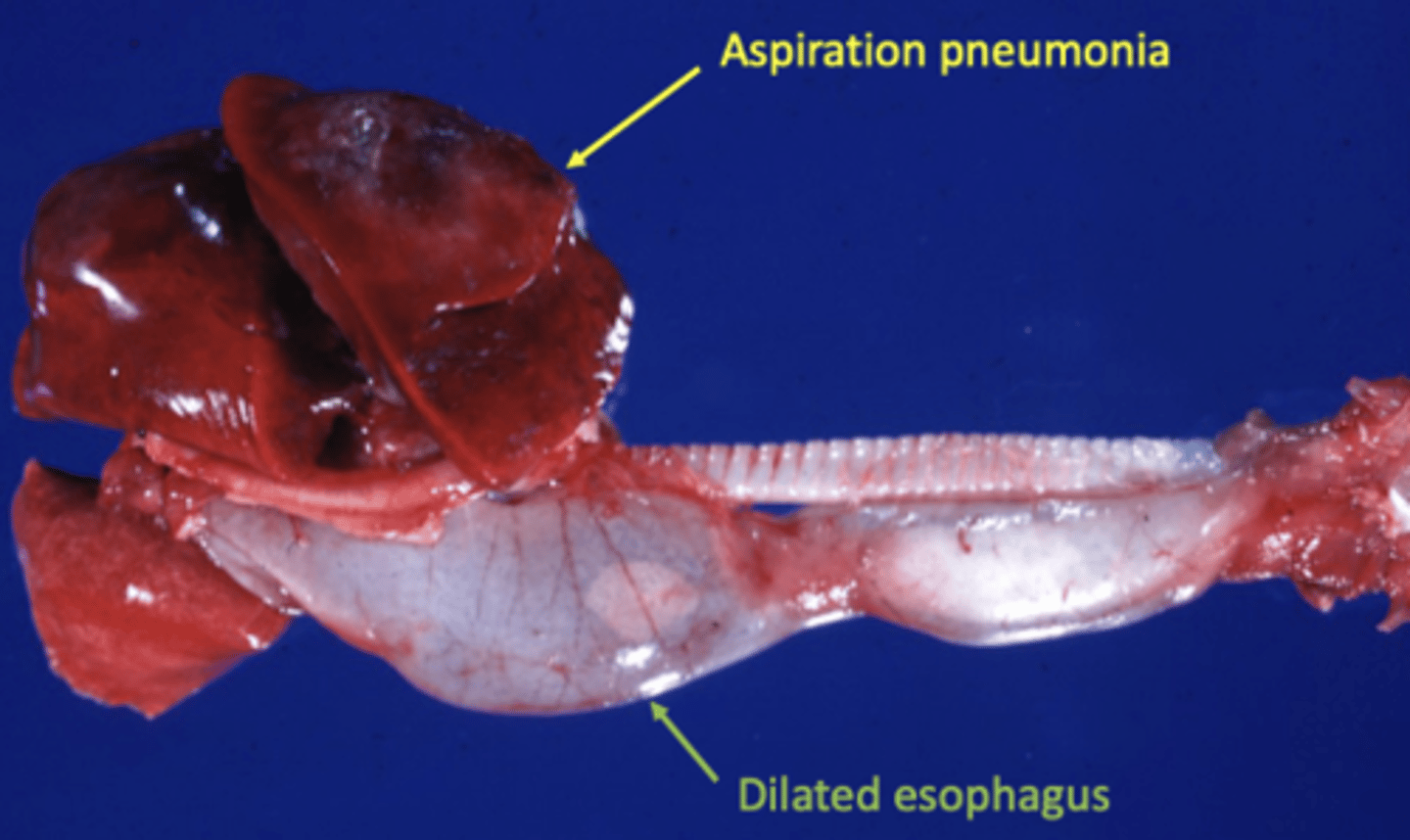
Describe the pathogenesis of a vascular ring anomaly leading to megaesophagus.
- Persistent right 4th aortic arch leading to esophageal entrapment and megaesophagus, creating a risk of aspiration pneumonia
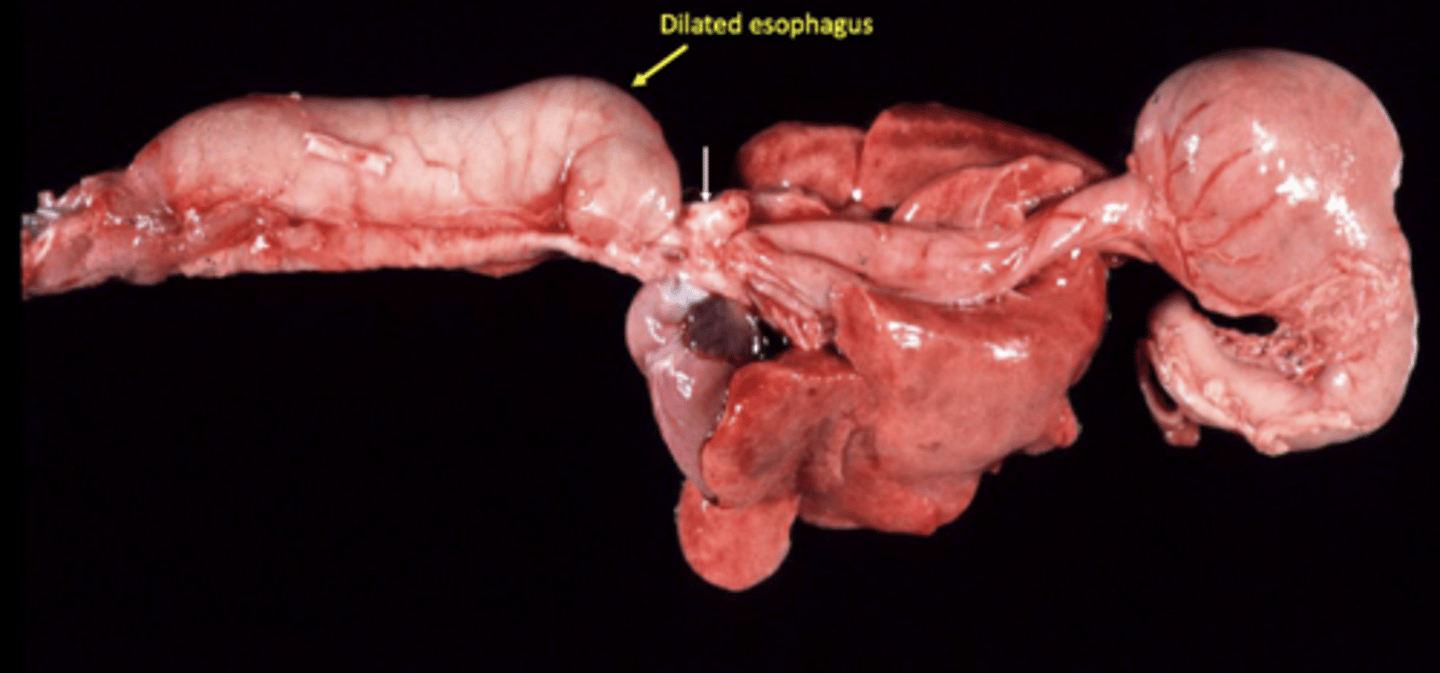
In what animals is vascular ring anomaly common?
- Most often, but not always, in younger animals since the stricture may not be complete
- Common in purebreds
How is a vascular ring anomaly treated?
- Surgical correction
What type of hypersensitivity is Myasthenia gravis? Describe the pathogenesis.
- Type II
- Antibodies against acetylcholine receptors in neuromuscular junction (NMJ)
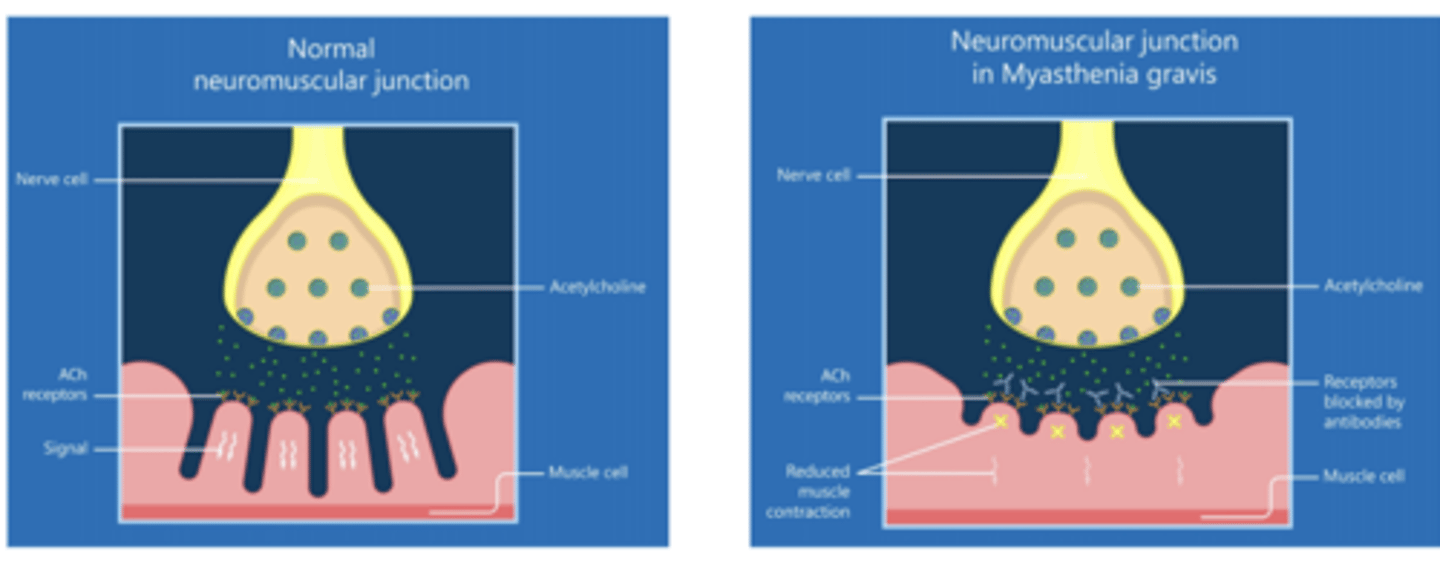
What is the most common esophageal disease of large animals?
- Choke
What is the cause of choke? What can it lead to?
- Ingestion of large materials (potatoes, apples, etc), or impacted feed
- Can cause circumferential scarring on mucosa

Which breed of horses is predisposed to Idiopathic hypertrophy of the distal esophagus? What is it associated with?
- Friesian horses (in other breeds -> Rarely clinically significant)
- Associated with esophageal rupture and megaesophagus
Esophagitis can lead to _______________.
- Perforation